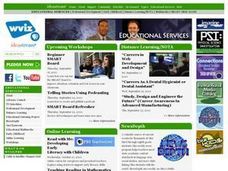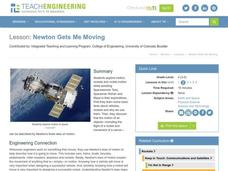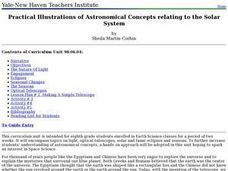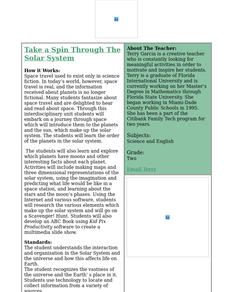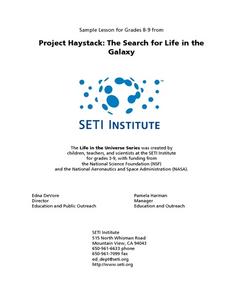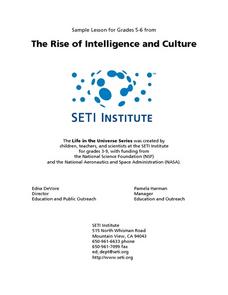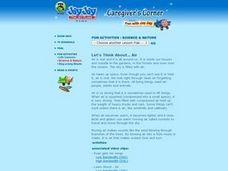Curated OER
Our Changing View of the Solar System
Students identify and name the eight planets and the five dwarf planets in our solar system. In this space science lesson, students view a slideshow of the planets and label them on an included Solar System chart.
Curated OER
Hot Air
High schoolers conduct an experiment to determine how hot air affect the path of laser. In this physics lesson plan, students explain why stars appear to twinkle at night. They discuss how light travels from space to Earth.
Curated OER
Sound
Students identify sources and importance of sound, discuss sounds heard on way to school, explain why sound waves can be "seen", and participate in various classroom activities and experiments that illustrate how sound travels.
Curated OER
"Let's Go!"
Students explore each mode of transportation: Land, Air, Sea and Space and which one you use for which purpose?
Curated OER
Gazing At Cosmic Pinballs
Learners explore the world of stars. They see that the color of a star tells how hot or cold it is, that stars come in different sizes. and that stars are moving through space. They draw lines connecting start to star.
Curated OER
Cosmic Wheels
Students build a scale model of the Solar System and determine the time other planets take to travel around the Sun in comparison to the time of the Earth's revolution. The velocity of the planets are also determined in this lesson plan.
Curated OER
Newton Gets Me Moving
Students discuss Newton's laws of motion. The conduct motion experiments by building "Newton Rocket Cars" from assorted materials. They propel the cars with rubber bands and wooden blocks and record the distance traveled on data sheets.
Curated OER
Practical Illustrations of Astronomical Concepts Relating to the Solar System
Eighth graders are introduced to concepts related to the Solar System. In groups, they participate in an experiment in which they must describe a ray of light and how it travels. They draw a diagram of the electromagnetic spectrum and...
Curated OER
CHARTING A COURSE
Students model how a gyroscope works with string, an old phonograph record and crayon.
Curated OER
Take a Spin Through the Solar System
Second graders participate in a variety of activities to explore the Solar System in this unit.
Curated OER
Space Crossing
Students critically follow a chain of reasoning to devise a decent problem solving technique to be applied to a reasonable problem. They also examine how to use logical arguments.
Curated OER
The Nature of Science and Technology
Learners study the environmental concerns of orbital debris. In this orbital debris lesson students complete several activities.
Curated OER
Colonizing the Stars
Students compare and contrast the size, composition and surface features of the nine planets of our solar system with the possible sizes and compositions of extra -solar planets.
Curated OER
Outerspace: Frontier for Personal Health and Hygiene
Students view photos of astronauts sleeping, eating, bathing, and using the toilet, and discuss hygiene problems in a zero-gravity environment. They contrast hygiene habits in space to those on Earth, and create storybooks illustrating...
Curated OER
Glowing Glimpses of Our Universe
Students will complete hands-on space activities. In this space science lesson, students will create a glow-in-the-dark model of the solar system, visit a planetarium, make star pictures, and paint constellations. Activities are meant to...
Curated OER
How Long Would It Take To Travel To the Stars?
Students consider the amount of time that it would take to get to the star, Sirius using various modes of transportation, some practical and some whimsical. The practicality of physically going to another star system is explored in this...
Curated OER
A DISAPPEARING ACT Astronomy: Do Stars Always Shine?
Learners observe why stars are not visible during the day with a classroom demonstration using an index card punched with holes.
Curated OER
Extraterrestrial Communication: Can We Talk to Anybody Out There?
Students examine the possibilities of communication with other living organisms within our solar system through research and hands on activities, as well as observing and analyzing teacher demonstrations.
Curated OER
Let's Think About Air
Students explore the concept that air is all around us and identify ways that we can use air, and what air can do. They watch a short video that illustrates some of their findings.
Curated OER
How Does Light Travel?
Sixth graders are read The Way to Start a Day by Byrd Baylor or Bear Shadow by Frank Asch. They discuss how the sun affects their daily life, 6th graders are encouraged to think about the light we recieve from the sun and how man has...
Curated OER
Pioneers of Space
Pupils explore how to use natural resources in the next millenium. Students create a KWL chart and then research information on our solar systsem, natural resources, and environments. Pupils build a model of a future community and write...
Curated OER
MARVIN K. MOONEY SCOOTER ACTIVITY
Pupils use scooter boards safely after listening to ways Marvin K. Mooney traveled on a scooter board.
Curated OER
My World is Upside Down
Students observe a demonstration on light. They construct a pinhole viewer, and explore and discuss the concept that light travels in a straight line.
Curated OER
Oodles of Noodles
Students practice various locomotor skills and creative movement. They find their self space with a noodle and follow the teacher's lead. They create stories to go along with the activities and use their imagination. i.e. "We are...
Other popular searches
- Pros Cons Space Exploration
- Space Travel Brochure
- Space Exploration Timeline
- Timeline of Space Travel
- Space Exploration Time Line
- Drama Space Travel
- 1950 Space Exploration
- Bill Nye Space Exploration
- History of Space Exploration
- Outer Space Travel
- Space Travel Reading
- History of Space Travel




